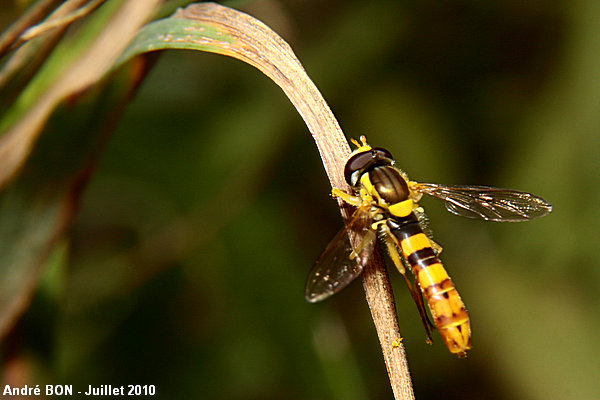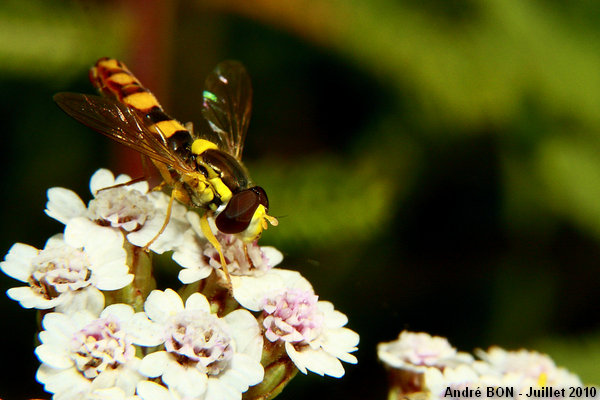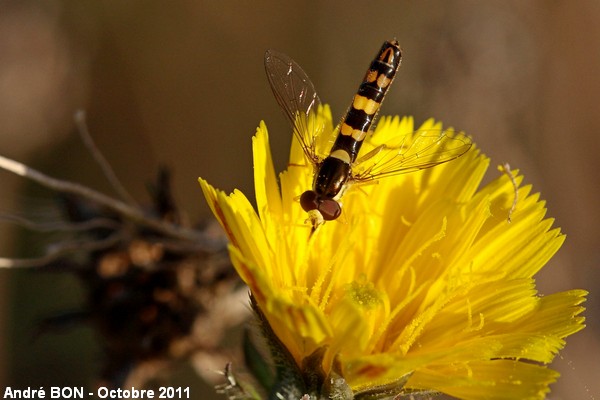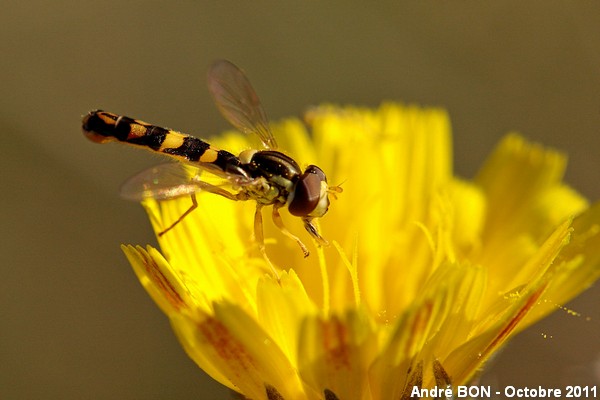




| Long Hoverfly (Sphaerophoria scripta (Linnaeus 1758)) |





|
|
Scientific name: Sphaerophoria scripta (Linnaeus 1758) Common name: Long Hoverfly French name: Syrphe porte-plume, Sphaerophore notée Order: Diptera Family: Syrphidae Wingspan : 7 to 12 mm. Biotope: Flower meadows. Geographic area: North Africa, Europe, Asia east to the Pacific coast. The Long Hoverfly is a migratory species. Observation period : April to November with a peak in July-August. |
The Long Hoverfly has a rather thin body. The thorax, which is grey with darker longitudinal stripes, shows a pale yellow lateral band on each side. This band is uninterrupted and reaches the scutellum which is also yellow. The abdomen, much more variable in colour, is black-and-yellow striped. It shows some small dark marks near the tip. They look like the nibs that were used for writing in the old days. The face is yellow and often marked with a small central diffuse brown patch. Only males are easy to recognize. The abdomen tip is enlarged and rounded. The wings are clearly shorter than the abdomen (this particularity is not present on the other species of the same genus). The male's eyes are touching. There are about 16 species of the Sphaerophoria genus in France and it is almost impossible to tell females apart with pictures. Let's mention that Sphaerophoria scripta is the most common species. Females have an abdomen which is broadened in the middle and with a pointed tip. The eyes are not touching. As an additional information, notice that the yellow stripe on the side of the thorax of Sphaerophoria rueppelli is interrupted before the base of the wings. The abdomen narrows on tergite 2 and 3. The tip is more orange. Male Sphaerophoria taeniata shows and abdomen with broad yellow stripes which are not interrupted in the centre. In particular, there is no black median line on the fifth tergite. The Long Hoverfly has a very fast reproduction cycle and there can be up to nine broods per year. The larvae feed on aphids. |
| [To know more about the Long Hoverfly] [Next picture] [Top] |

|
Here is a male with its touching eyes and with its rounded abdomen's tip. You could imagine that if the wings were held over the abdomen, this last one would clearly exceed them in length. |
| [To know more about the Long Hoverfly] [Next picture] [Previous picture] [Top] |

|
There are many Long Hoverflies on the umbelliferae flowers in summer. |
| [To know more about the Long Hoverfly] [Next picture] [Previous picture] [Top] |

|
Here is a female with its separated eyes and its pointed abdomen tip. It is not possible to be sure of the species identification. There is only a 95% probability that this is Sphaerophoria scripta based on the fact that it is by far the most abundant species of the genus. I will try to shoot pictures of mating. Telling the male species apart will enable to confirm the female species. |
| [To know more about the Long Hoverfly] [Next picture] [Previous picture] [Top] |

|
The touching eyes and the rounded abdomen tip indicate one male. I have only listed this one as Sphaerophoria sp because the wings do not appear to me as very much shorter than the abdomen. |
| [To know more about the Long Hoverfly] [Previous picture] [Top] |

|
Here is another picture of the male shown above. The yellow stripe on the side of the thorax appears interrupted but this may be just an impression given by lighting and shadows. The previous picture does not show any narrowing of the abdomen on tergites 2 and 3. This would have indicated the Sphaerophoria rueppelli species. |